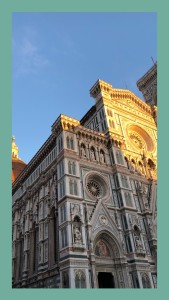
Con la definitiva decadenza dell’impero romano le costruzioni fuori mura, come questa, rimasero facili vittime degli assedi e delle devastazioni di Goti e Longobardi che finirono col prendere possesso di Firenze. A queste vicende, molto probabilmente, si deve la distruzione della basilica paleocristiana.
La costruzione della nuova chiesa avvenne nell’XI secolo. Al 1055 con il Concilio di Firenze si ebbe la prima menzione documentaria di un annesso monastero di monache benedettine. Il 7 novembre 1057 Papa Niccolò II consacrò la nuova chiesa e il nuovo monastero. Di questa chiesa, di epoca e stile romanici, oggi restano solo pochi ma notevoli resti incorporati nelle case e nei locali di servizio in piazza Santa Felicita. L’aspetto odierno risale al XVIII secolo.
——————————
The early Christian church was founded towards the end of the 4th century. A.D. at the opposite end of the Basilica of San Lorenzo, in the village existing beyond the Arno river: the two poles of Florentine Christianity, built in opposite areas, both outside the walls that delimited the pagan city.
The excavations carried out in the 1940s have brought to light the remains of an early Christian cemetery basilica, substantially coeval with S. Lorenzo, late 4th-early 5th century. The area had monumental tombs, as it often happened in areas of high transit just outside the city gates. The basilica had three naves, 26 meters wide and about 38 long and inside the church there was the cemetery area for the Christian community which brought to light interesting funerary epigraphs. In the subsoil there are a series of tunnels, from which it is also possible to see a stretch of the remains of the Roman Via Cassia, a few meters below today’s ground level.
In the nearby Piazza dei Rossi, a section of the side of the basilica was found with construction characteristics very similar to those of the facade. The numerous epigraphs found, now on display in the entrance hall to the right of the church, date from the early fifth to the mid-sixth century AD. , and made it possible to discover that the basilica was at the center of the spiritual life of a community also made up of a group of Syrian origin, probably merchants who arrived by sea, landing at the mouth of the Arno, or who arrived from Rome via Cassia Adrianea.
With the definitive decline of the Roman Empire, buildings outside the walls, like this one, remained easy victims of the sieges and devastations of Goths and Lombards who ended up taking possession of Florence. These events are most likely due to the destruction of the early Christian basilica.
The construction of the new church took place in the 11th century. In 1055 with the Council of Florence the first documentary mention was made of an annexed monastery of Benedictine nuns. On 7 November 1057 Pope Nicholas II consecrated the new church and the new monastery. Of this church, of Romanesque epoch and style, today only a few but remarkable remains remain incorporated in the houses and in the service rooms in Piazza Santa Felicita. Today’s appearance dates back to the 18th century.
www.facebook.com/adayinflorence
www.instagram.com/adayinflorence














